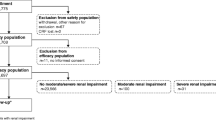Abstract
Despite the differences in imaging conditions and the range of approved indications for gadolinium-based contrast agents, the similarities in the structures of these substances have so far resulted in largely similar safety profiles. Nevertheless, some safety-related questions have been raised recently, which indicates that the existing differences in the physicochemical and pharmacokinetic properties of these contrast agents may result in differences in some aspects of the safety profile, in particular for special populations under particular circumstances. An analysis of the current data shows that Gadobutrol and Gadofosveset are well tolerated in the investigated patient populations. Both contrast agents have comparable adverse events profiles.
Similar content being viewed by others
References
Claussen C, Laniado M, Schörner W et al. (1985) Gadolinium-DTPA in MR imaging of glioblastomas and intracranial metastases. Am J Neuroradiol 6(5):669–674
Niendorf HP, Laniado M, Semmler W, Schorner W, Felix R (1987) Dose administration of gadolinium-DTPA in MR imaging of intracranial tumors. Am J Neuroradiol 8(5):803–815
Rohrer M, Bauer H, Mintorovitch J, Requardt M, Weinmann H-J (2005) Comparison of magnetic properties of MRI contrast media solutions at different magnetic field strengths. Invest Radiol 40:715–724
Zhang HL, Ersoy H, Prince MR (2006) Effects of gadopentetate dimeglumine and gadodiamide on serum calcium, magnesium and creatinine measurements. J Magn Res Imaging 23:383–387
Marckmann P, Skov L, Rossen K et al. (2006) Nephrogenic systemic fibrosis: suspected causative role of gadodiamide used for contrast-enhanced magnetic resonance imaging. J Am Soc Nephrol 17:2359–2362
Maloo M, Abt P, Kashyap R et al (2006) Nephrogenic systemic fibrosis among liver transplant recipients: a single institution experience and topic update. Am J Transplan 6:2212
Thomsen HS, Morcos SK, Dawson P (2006) Is there a causal relation between the administration of gadolinium-based contrast media and the development of nephrogenic systemic fibrosis (NSF)? Clin Radiol 61:905–906
Multicenter, intra-individually controlled, open-label study of 1 molar gadobutrol in patients with CNS lesions, data on file AI68, Schering AG, Germany (1996)
Deo A, Fogel M, Cowper SE (2007) Nephrogenic systemic fibrosis: a population study examining the relationship of disease development to gadolinium exposure. Clin J Am Soc Nephrol 2:264–267
Staks T, Schuhmann-Giampieri G, Frenzel T, Weinmann HJ, Lange L, Platzek J (1994) Pharmacokinetics, dose proportionality, and tolerability of Gadobutrol after single intravenous injection in healthy volunteers. Invest Radiol 29:709–715
Vogler H, Platzek J, Schuhmann-Giampieri G et al (1995) Pre-clinical evaluation of Gadobutrol: a new, neutral, extracellular contrast agent for magnetic resonance imaging. Eur J Radiol 21:1–10
Balzer JO, Loewe C, Davis K (2003) Safety of contrast-enhanced MR angiography employing Gadobutrol 1.0 M as contrast material. Eur Radiol 13:2067–2074
Tombach B, Heindel W (2002) Value of 1.0-M gadolinium chelates: review of preclinical and clinical data on Gadobutrol. Eur Radiol 12:1550–1556
Forsting M (2008) Gadovist 1.0-M: tolerance and clinical safety. Eur Radiol 18(Suppl 1):324–325
Tombach B, Bremer C, Reimer P (2000) Pharmacokinetics of 1M Gadobutrol in patients with chronic renal failure. Invest Radiol 35:35
Tombach B, Bremer C, Reimer P et al. (2001) Renal tolerance of a neutral gadolinium chelate (Gadobutrol) in patients with chronic renal failure: results of a randomized study. Radiology 218:651–657
Tombach B, Bremer C, Reimer P et al. (2002) Using highly concentrated Gadobutrol as an MR contrast agent in patients also requiring hemodialysis: safety and dialysability. Am J Roentgenol 178:105–109
Safety, tolerability and pharmacokinetics of gadobutrol 1 molar in a dose range of 0.3–1.5 mmol/kg b.w. in healthy volunteers, data on file B000, Schering AG, Germany (1999)
Huppertz A, Rohrer M (2004) Gadobutrol, a highly concentrated MR-imaging contrast agent: its physicochemical characteristics and the basis for its use in contrast-enhanced MR angiography and perfusion imaging. Eur Radiol 14(Suppl 5):M12–18
ClinicalTrails.gov. [online]. Available from URL http://www.clinicaltrials.gov
Goyen M, Edelman M, Perreault P et al. (2005) MR angiography of aortoiliac occlusive disease: a Phase III study of the safety and effectiveness of the blood-pool contrast agent MS-325. Radiology 236:825–833
Rapp JH, Wolff SD, Quinn SF et al. (2005) Aortoiliac occlusive disease in patients with known or suspected peripheral vascular disease: safety and efficacy of Gadofosveset-enhanced MR angiography - multicenter comparative Phase III study. Radiology 236:71–78
European Medicines Agency. Vasovist: summary of product characteristics. [online]. Available from http://www.emea.eu.int/
Shamsi K, Yucel EK, Chamberlin P (2006) A summary of safety of Gadofosveset (MS-325) at 0.03 mmol Gd/kg body weight dose. Invest Radiol 41:822–830
Cowper SE, Robins HS, Steinberg HM, Su LD, Gupta S, Leboit PE (2000) Scleromyxedema-like cutaneous diseases in renal-dialysis patients. Lancet 356:1000–1001
Grobner T (2006) Gadolinium - a specific trigger for the development of nephrogenic fibrosing dermopathy and nephrogenic systemic fibrosis? Nephrol Dial Transplant 21:1104–1108. Erratum in Nephrol Dial Transplant 2006:21(6):1745. Comment in Nephrol Dial Transplant 2006:21(12):3604–3605 and Nephrol Dial Transplant 2006:21(11):3344
Broome DR, Girguis MS, Baron PW, Cottrell AC, Kjellin I, Kirk GA (2007) Gadodiamide-associated nephrogenic systemic fibrosis: why radiologists should be concerned. AJR Am J Roentgenol 188(2):586–592
Khurana A, Runge VM, Narayanan M, Greene JF Jr, Nickel AE (2007) Nephrogenic systemic fibrosis: a review of 6 cases temporally related to gadodiamide injection (Omniscan). Invest Radiol 42(2):139–145
Idée JM, Port M, Raynal I, Schaefer M, Le Greneur S, Corot C (2006) Clinical and biological consequences of transmetallation induced by contrast agents for magnetic resonance imaging: a review. Fundam Clin Pharmacol 20:563–576 (review). Erratum in Fundam Clin Pharmacol 2007:21:335
Author information
Authors and Affiliations
Corresponding author
Rights and permissions
About this article
Cite this article
Palkowitsch, P., Voth, M. Summary of the safety data for Gadobutrol and Gadofosveset. Eur Radiol Suppl 18 (Suppl 5), 47–53 (2008). https://doi.org/10.1007/s10406-009-0245-5
Published:
Issue Date:
DOI: https://doi.org/10.1007/s10406-009-0245-5




